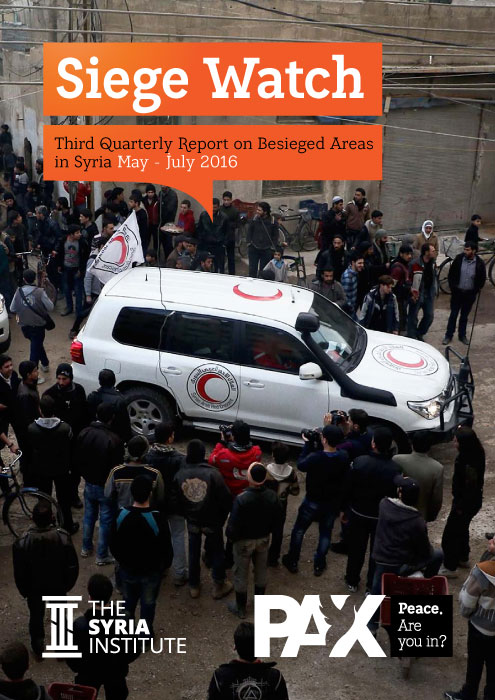More than one million Syrians remain under siege. The recent cease-fire agreement between the United States and Russia can contribute to relief for civilians in Syria, but lifting the sieges and ending the illegal strategy of starvation of one million Syrians should be top priority of the accord.
In addition to those still under siege, more than 1.4 million were under threat to become fully besieged, including over 200,000 residents of eastern Aleppo. The Siege Watch: Third Quarterly Report on Besieged Areas in Syria, a joint effort by The Syria Institute in Washington, DC and the Dutch NGO PAX, covers the period from May to July 2016.
Deterioration
The report shows that life for those under siege has gotten dramatically worse over the past few months. Military attacks on besieged communities have dramatically increased. Hospitals and other civilian infrastructure continue to be targeted. Delivery of humanitarian assistance has decreased.
“We are alarmed by the dramatic deterioration of the situation, which bring besieged communities to the point of collapse,” says PAX programme leader Marjolein Wijninckx. “Despite international momentum to lift the sieges in June, conditions have only worsened for besieged communities.”
End game?
Syrian government forces have escalated attacks on besieged communities in an apparent attempt to create ´facts on the ground´ before any cease-fire settlement comes into effect. Since the end of July the critically-besieged community of Darayya surrendered to Syrian government forces after months of non-stop bombardment, starvation and the destruction of its last hospital. All remaining citizens were evacuated in late August, and Darayya is now empty. Other besieged communities such as Al-Waer are at risk of following a similar fate.
“Over the summer we saw a preview of the Syrian military´s strategy for besieged areas moving forward: extreme escalation of violent attacks, coercive surrender, and forcible population displacement,” says Valerie Szybala, Executive Director of The Syria Institute. “If these outcomes are unacceptable to the international community, the UN and the International Syria Support Group must take quick and firm action. Time is of the essence.”
While the number of besieged areas has fallen, it has not led to a corresponding decrease in the number of people under siege. In addition to violating a number of United Nations Security Council Resolutions, the deliberate starvation of civilians is a grave breach of the Fourth Geneva Convention, and therefore a war crime.
Not over yet
The agreement between the United States and Russia could begin a process to alleviate the suffering of populations under siege. Lifting the sieges and stopping the illegal starvation of one million Syrians requires a firm, sustained political response. “Aid convoys will not solve the problem of the sieges,” according to Wijninckx. “Concerted pressure is needed for the sieges to be lifted and people and goods be allowed to move freely.”
See Siege Watch: Third Quarterly Report on Besieged Areas in Syria,




